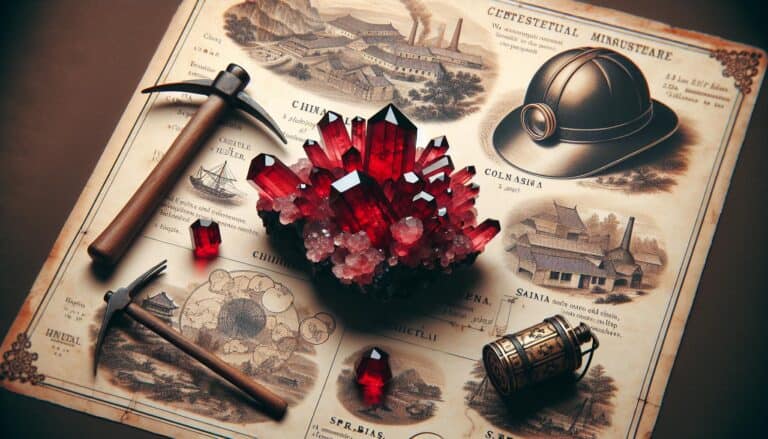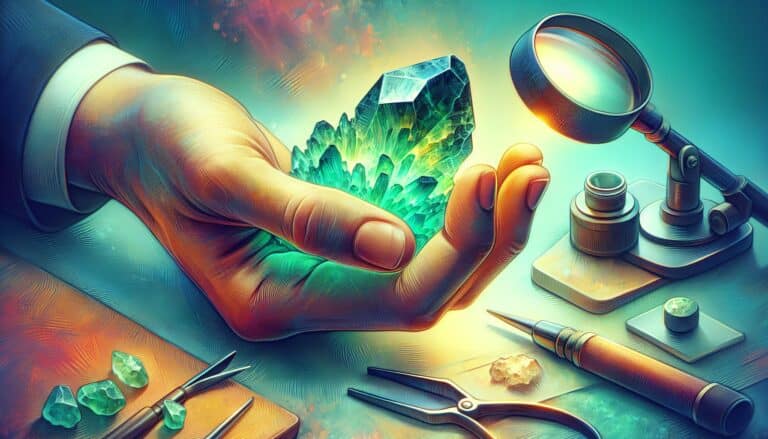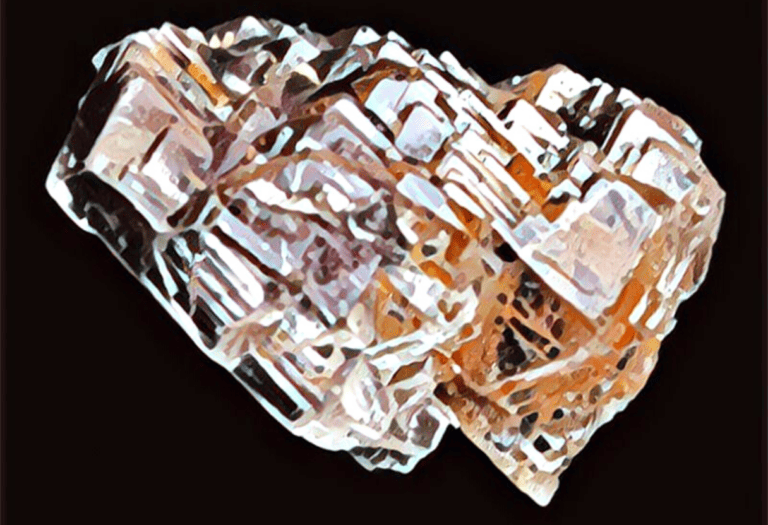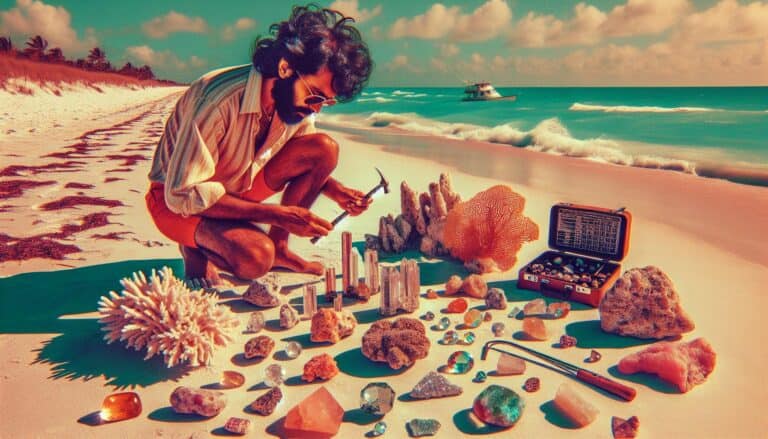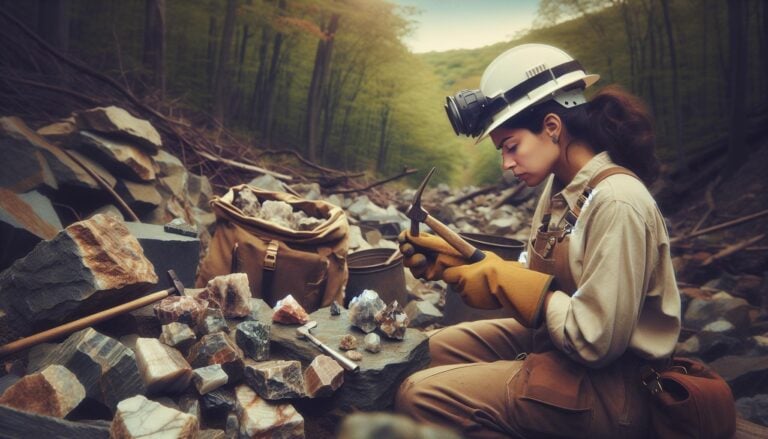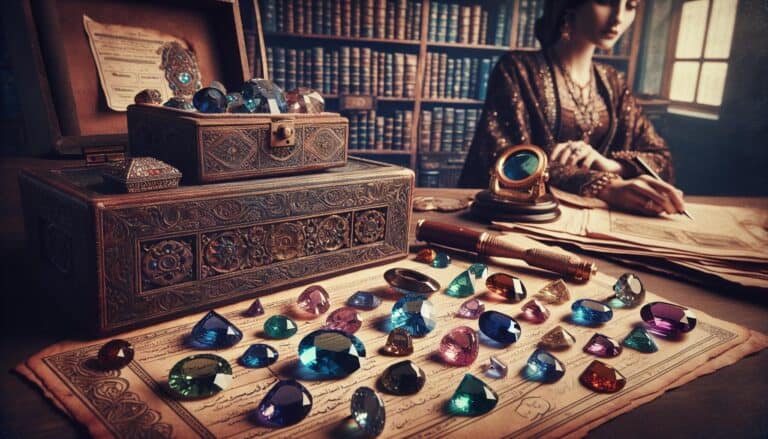Unearthing the mystical beauty of labradorite starts with knowing how to identify it.
This enchanting stone captivates with its labradorescence, a unique play of colors that seems to dance beneath the surface. If you’re keen to discover how to spot genuine labradorite, you’re in the right place.
You’ll find that labradorite isn’t just another pretty rock; it’s a feldspar mineral with distinct characteristics. From its striking iridescence to its rich history, learning to identify labradorite can be as rewarding as it is fascinating.
Let’s delve into the telltale signs that set this gemstone apart.
To identify labradorite, look for its unique iridescence, or labradorescence, displaying spectral colors. This gemstone is typically translucent to opaque, with a Mohs hardness of 6-6.5. It’s not magnetic and leaves a white streak. Labradorescence and hardness tests are key to spotting genuine labradorite.
How to Identify Labradorite Through Testing
When you’re on the hunt for genuine labradorite, hands-on testing is your go-to strategy. Let’s deep-dive into the array of tests you can perform to confirm that you’ve struck gemstone gold.
Visual Inspection
Spot labradorite with your own eyes by looking for the specimen’s signature iridescence. The spectral play of colors, mainly blues and greens, should flash as you rotate the stone. Check for a lustrous, pearly sheen — a hallmark of true labradorite.
The Streak Test
Drag your labradorite across a piece of unglazed porcelain tile. Unlike harder minerals, labradorite leaves a white streak, which indicates its softer nature. This simple test is quick and effective.
Magnet Test
Real labradorite isn’t magnetic, so it won’t react to a magnet. If the stone you’re testing is drawn to the magnet, it’s likely not authentic labradorite but another mineral altogether.
Hardness Test
Using the Mohs scale, labradorite ranks at about 6-6.5 for hardness. You can test this by trying to scratch your stone with a steel file. If the file leaves a mark, the mineral is probably not labradorite.
Birefringence Test
Labradorite displays a phenomenon known as birefringence, where light splits into two rays as it passes through the mineral. Through a polariscope, you should observe a variance in light transmission, indicating birefringence.
Checking The Diaphaneity
Examine how light passes through labradorite; it should be translucent to opaque. If it’s too transparent or doesn’t allow light to pass through at all, it might be another mineral.
Single or Double Refraction
Using a dichroscope, check for single or double refraction within the stone. Labradorite, being a member of the plagioclase series, typically shows double refraction, helping to differentiate it from look-alikes.
Refractive Index Test
Professional gemologists measure labradorite’s refractive index to confirm its identity. The typical refractive index range for labradorite is between 1.560 and 1.572. This requires specialized equipment but provides a definitive test result.
Finding The Specific Gravity
Another precise test involves measuring labradorite’s specific gravity, which generally lies between 2.69 and 2.72. Variations could suggest you’re dealing with a different mineral.
Identifying Labradorites in the Field
When searching for labradorite in nature, keep your eyes peeled for anorthosite rock formations, as labradorite often occurs within these. Look for the distinctive flashes of color that characterize this unique mineral.
Recognizing Potential Labradorite Rocks
In the field, potential labradorite rocks may not immediately show labradorescence. Use a wet sponge to bring out the colors, and be aware of the mineral’s typical gray-green, dark gray, or black base colors which could hint at labradorite presence even before tests confirm it.
Labradorite can be mesmerizing, and identifying it correctly can be just as rewarding as finding it. With the right knowledge, you’re well-equipped to spot this enchanting gemstone.
Physical Characteristics of Labradorite
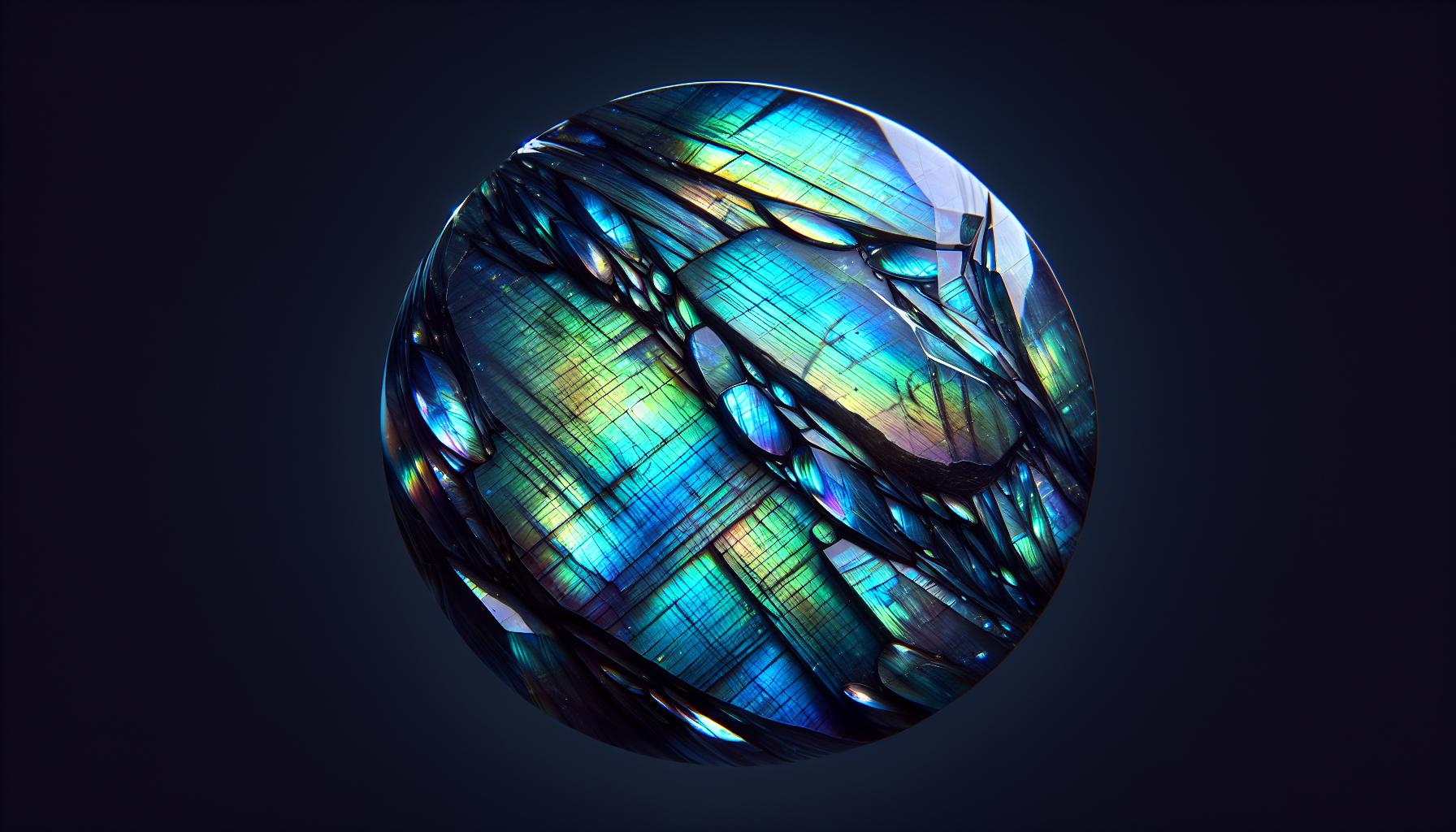
Labradorite is a fascinating mineral that stands out with its unique physical properties. When you’re on the hunt for this gemstone, there are specific characteristics you’ll want to look out for. First and foremost, labradorite showcases a remarkable play of colors, known as labradorescence. This phenomenon occurs due to light refracting within the layers of the stone, giving it an otherworldly glow that can include blues, greens, oranges, and even purples.
To the touch, labradorite feels relatively hard; it rates a 6-6.5 on the Mohs scale of hardness. This indicates a good resistance to scratches, something to consider when you’re testing samples in the field. The cleavage is perfect in one direction, meaning it breaks along flat planes, which is a telltale sign you’re dealing with genuine labradorite.
In terms of transparency, labradorite ranges from transparent to translucent to opaque. The most sought-after pieces are those that display transparency with vibrant flashes of color. Remember, the quality of the iridescence is a crucial identifier—finer specimens will exhibit a full spectrum of colors at various angles.
- Inspect for labradorescence
- Check hardness (6-6.5 on Mohs scale)
- Observe cleavage and transparency
Labradorite is also distinctive in weight—it has a specific gravity between 2.68 and 2.72, which feels heavier than average glass but lighter than metals like iron or copper.
When you’re examining potential labradorite samples, look out for these physical traits. By familiarizing yourself with the tactile and visual characteristics, you’ll enhance your ability to distinguish labradorite from other minerals effectively.
How Are Labradorite Formed?
Labradorite’s formation is a tale as fascinating as its appearance. Formed within igneous rocks, often specifically in basalt and gabbro, labradorite crystallizes from molten magma beneath the Earth’s surface. This process is known as magmatic differentiation, which separates different minerals into layers as they solidify at different temperatures.
As you delve deeper, you’ll find that plagioclase feldspar is the family to which labradorite belongs. Over time, through a process of cooling and crystallization, labradorite takes form. The slow cooling allows ample time for the crystals to develop, resulting in the large, well-formed crystals that characterize this gemstone.
The spectacular color play, known as labradorescence, arises from light interference within the layers of feldspar comprising the stone. What you witness is a result of microscopic lamellar intergrowths inside the crystal. These intergrowths create thin layers that refract light as it enters the stone, producing the extraordinary colors labradorite is celebrated for.
In addition to finding labradorite within anorthosite rock formations, it’s also discovered as detrital grains in sedimentary deposits. This happens as a result of weathering and erosion spreading the labradorite from its original igneous source. Your knowledge of these geological processes enhances your ability to recognize and locate labradorite specimens in various environments.
Preparation for Labradorite Hunting
Before setting out on your quest to find the captivating labradorite, it’s essential that you’re well-prepared. Having the right gear and understanding safety considerations will not only enhance your hunting experience but also ensure you’re able to identify labradorite efficiently.
Gathering the Right Tools
Your success in locating labradorite greatly depends on the tools you bring along. Here’s a list of must-have items:
- Geologist’s hammer or pickaxe: For extracting samples from host rock.
- Hand lens or jeweler’s loupe: Magnification is key for close inspection of potential finds.
- Field guidebook on rocks and minerals: Helps with on-the-spot identification and provides essential geological context.
- Notebook and pen: Keep records of the locations and characteristics of your finds.
Additional items that could come in handy include:
- A sturdy backpack to carry your tools and finds.
- Plastic bags or containers to protect the labradorite.
- A GPS device or a detailed map of the area to navigate remote locations.
Ensure you familiarize yourself with these tools before embarking on your trip. Efficient use of the tools will streamline your identification process and increase the odds of uncovering labradorite specimens.
Safety Considerations
Safety should be your top priority when hunting for labradorite, especially if you’re venturing into remote or rough terrain. Key safety tips include:
- Wear appropriate protective gear: Safety glasses, gloves, and a hard hat can safeguard you from potential hazards.
- Bring ample water and food: Stay hydrated and energized during your expedition.
- Pay attention to weather and terrain: Conditions can change rapidly, so it’s vital to be prepared for the elements.
- Never hunt alone: Having a partner ensures that help is at hand in case of an emergency.
Being aware of local wildlife and having a first-aid kit on you at all times can make a significant difference in ensuring your safety. Additionally, informing someone of your whereabouts and expected return time is a smart move that should never be overlooked.
By equipping yourself with necessary gear and adhering to safety norms, you’ll be set to locate and identify labradorite with confidence and ease. Remember, preparation is the precursor to success in your labradorite hunting adventures.
Handling and Care of Found Labradorite

Upon successful identification of labradorite, it’s crucial to know how to handle and care for these gemstones. Proper techniques ensure your newfound treasures maintain their iridescent beauty for years to come.
Cleaning Labradorites
Handling minerals from the field often means you’re dealing with dirt and debris. Cleaning labradorite is straightforward but requires a gentle touch to avoid scratching the stone’s surface. Start by rinsing the stone with lukewarm water, using a soft brush like a toothbrush to lightly scrub away any dirt. Avoid acidic cleaners or harsh chemicals, as they can damage the labradorite.
Next, dry the stone with a soft cloth. It’s best to let labradorite air dry completely before storing to prevent any water marks or potential water damage. If your stone has a significant amount of dirt encrusted, consider soaking it in water with a mild soap for a few hours before scrubbing gently.
Storing Labradorites
After your labradorite is clean and dry, you’ll want to store it in a manner that protects its unique qualities:
- Use soft bags or fabric-lined boxes to cradle each stone, preventing scratches.
- Keep labradorite away from direct sunlight, as extended exposure can fade the stone’s vibrant colors.
- Separate labradorite from other stones, especially those with higher hardness levels, to avoid unwanted abrasions.
- Maintain a stable environment with consistent humidity and temperature levels to prevent any cracking or damage due to extreme conditions.
Labradorite’s care doesn’t end with just cleaning and storing. Regular handling and exposure to the elements can affect its luster and color. It’s also important to be mindful of the potential fragility of labradorite while out in the field or when incorporating it into jewelry. With the right care, the spectral play-of-color that makes labradorite so mesmerizing will continue to enchant.
Conclusion: Confirming Labradorite is Real
Armed with the knowledge of labradorite’s unique characteristics and the practical know-how of fieldwork, you’re well-equipped to embark on your own quest for this mesmerizing gemstone.
Remember, the key to success lies in careful observation and the judicious use of tests to confirm authenticity. Whether you’re in the field or examining a potential find at home, your new skills will serve you well. With the right tools and safety measures in place, you’re ready to uncover the hidden treasures of the earth. Treat each labradorite with the care it deserves, and it’ll reward you with its iridescent beauty for years to come.
Happy hunting!


